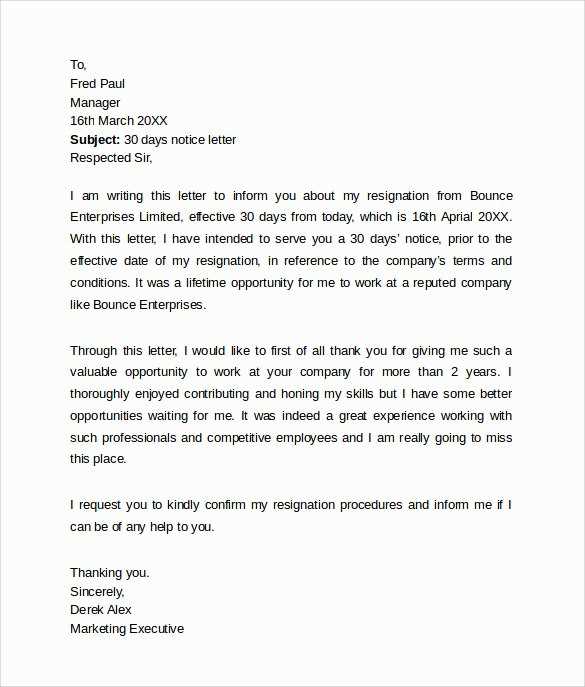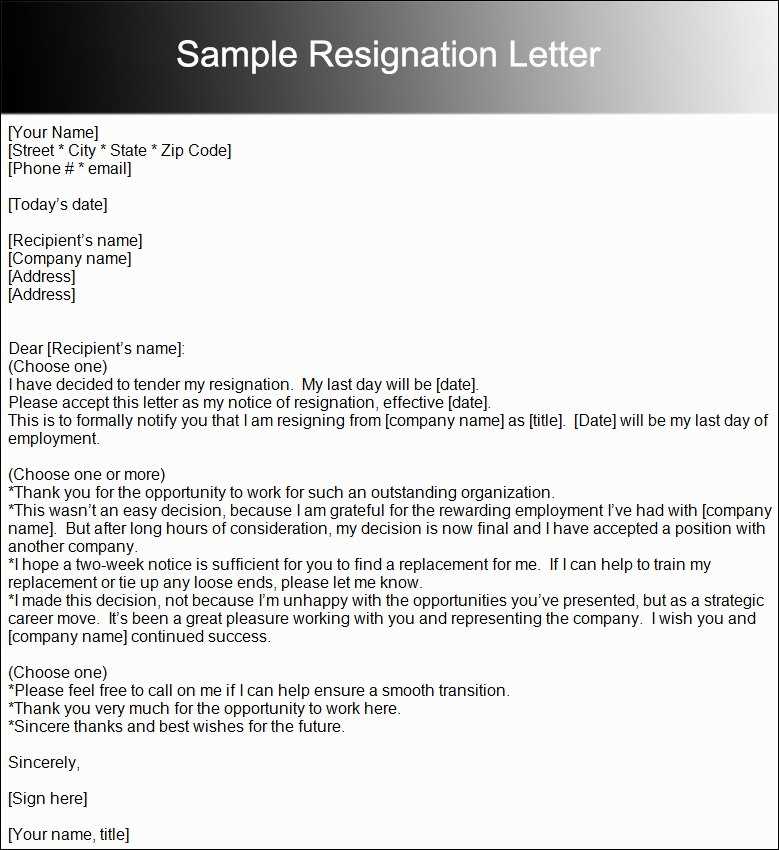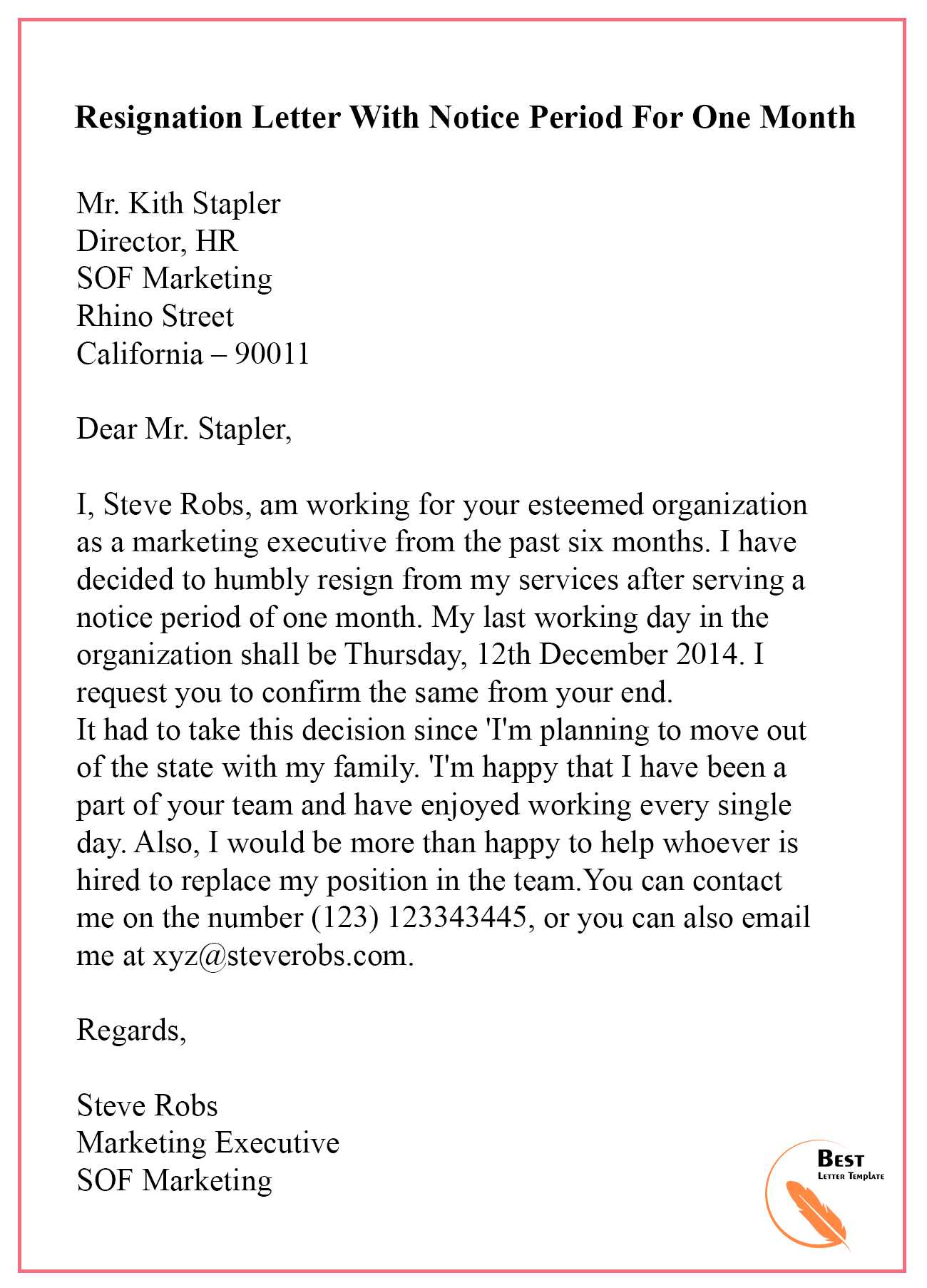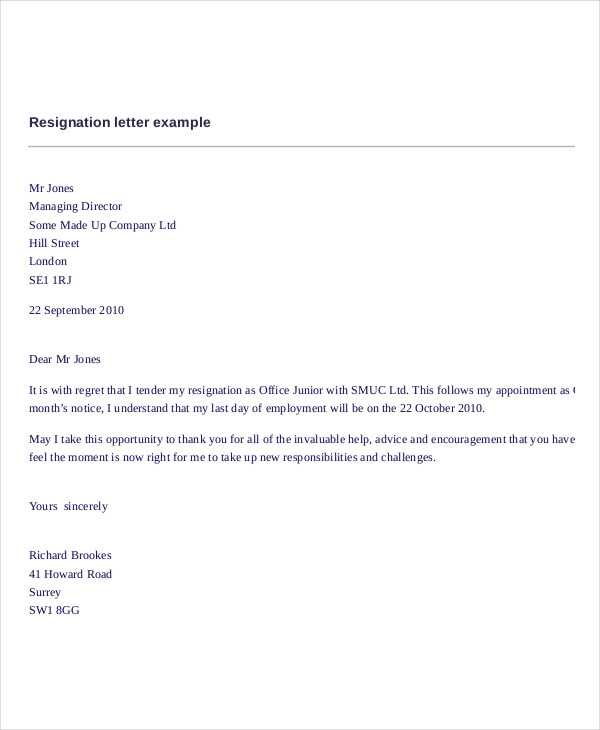30 Day Notice Resignation Letter Template for Employees

When leaving a job, it is important to provide your employer with a clear and respectful written statement in advance. This serves as a professional courtesy and ensures that both parties are prepared for the transition. A well-crafted communication can help maintain a positive relationship and leave a lasting impression.
Effective communication plays a crucial role in ensuring that your departure is smooth and that you fulfill any contractual obligations. By following the proper format and including key elements in your correspondence, you can make the process as seamless as possible.
In this guide, we will explore the essential components of such a communication, tips for structuring your message, and common pitfalls to avoid. This will help you prepare a comprehensive and thoughtful message to your employer.
Essential Elements of a Resignation Letter
When preparing to formally leave your position, certain key aspects should be included in your written statement to ensure clarity and professionalism. These elements provide structure and convey your intentions effectively. The following table outlines the essential components of such a message.
| Element | Description |
|---|---|
| Opening Statement | Begin with a clear statement expressing your intention to end your employment. |
| Effective Date | Include the date when your departure will take effect, typically allowing time for transition. |
| Gratitude | Thank your employer for the opportunity and any positive experiences during your tenure. |
| Transition Support | Offer assistance in making the transition smooth, including training a replacement if necessary. |
| Closing Remarks | End on a positive note, expressing well wishes for the future and leaving a professional impression. |
By including these elements, you ensure that your communication is both professional and respectful, helping to maintain a positive relationship with your employer.
How to Write a 30 Day Notice
When preparing to inform your employer of your decision to leave, it’s essential to be clear, concise, and professional. The way you structure this communication can make a significant difference in how your departure is perceived and the overall transition process. Follow these steps to ensure your message is well-crafted and effective.
- Start with a clear intent: Make sure to begin by directly stating your decision to leave the company and the intended final date.
- Specify your transition time: Mention the length of time you are offering before your departure, giving your employer ample time to adjust.
- Express gratitude: Thank your employer for the opportunities and experiences during your time with the company. This leaves a positive impression.
- Offer assistance: Include a willingness to help with training a replacement or ensuring a smooth handover of responsibilities.
- Maintain professionalism: Keep the tone respectful and formal, avoiding any negative remarks or personal grievances.
By following these simple guidelines, you can ensure your departure is handled professionally and amicably, keeping doors open for future opportunities.
Key Phrases for Resignation Letters
Crafting a clear and professional message when leaving a position involves using appropriate language that conveys your intentions while maintaining a positive tone. Certain phrases can help structure your communication, making it both polite and effective. Below are some key expressions to include in your message.
Introduction Statements
- “I am writing to formally inform you of my decision to leave the company.”
- “I wish to notify you of my intention to end my employment with [Company Name].”
- “Please accept this communication as my formal declaration to depart from my role.”
Closing Remarks

- “I am grateful for the opportunity to have worked with such a great team.”
- “Thank you for your understanding and support during this time of transition.”
- “I appreciate all the experiences I’ve gained and wish the company continued success.”
By incorporating these phrases, you can ensure that your message remains professional, respectful, and tactful, helping to preserve a positive relationship with your employer.
Best Practices for Submitting Your Notice
Submitting your formal decision to leave a company requires careful consideration to ensure a smooth transition. The way you deliver this message plays a key role in maintaining professional relationships and ensuring everything proceeds without disruption. Below are best practices to follow when submitting your intention to depart.
Timing and Delivery
- Provide ample time: Ensure you are giving your employer enough time to make necessary adjustments. Typically, a two-week period is standard, but it can vary depending on your role and company policies.
- Choose the right medium: A written format is always preferred, but consider delivering it in person first, followed by a formal document. This approach shows respect and maintains transparency.
Professionalism and Tone
- Stay positive: Regardless of the reasons for your departure, keep the tone positive and focused on gratitude for the experience.
- Avoid burning bridges: Leaving on good terms ensures you preserve valuable professional connections for the future.
By following these best practices, you ensure that your decision is communicated effectively and professionally, setting the stage for a positive exit and lasting relationships.
Common Mistakes to Avoid in Resignation Letters

When preparing your formal statement of departure, it’s important to avoid certain mistakes that could impact your professionalism or leave a negative impression. By being mindful of these common errors, you can ensure your message remains respectful and clear.
- Not Providing Sufficient Time: Failing to offer enough notice can create difficulties for your employer. Ensure that you provide an appropriate time frame for transition.
- Being Too Informal: Keep your tone professional and respectful. Avoid overly casual language, as it may appear unprofessional.
- Burning Bridges: Negative comments or complaints should be avoided. Keep your reasons for leaving brief and focus on the positives.
- Leaving Out Key Details: Make sure to include the essential information, such as your final working date and any offers of assistance during the transition period.
- Neglecting to Proofread: Typos and errors can diminish the quality of your message. Always proofread your communication before submitting it.
By avoiding these common mistakes, you can ensure that your departure is handled professionally and leaves a positive lasting impression.
What to Include in Your Final Letter
When preparing your final communication to leave a position, it’s important to include all necessary details to ensure a smooth departure. A well-structured message can help convey your intentions clearly while maintaining a professional tone. Below are key elements to include in your final message.
- Clear intention to depart: Start by clearly stating your decision to leave the company and the date you plan to end your employment.
- Reason for departure: While not required, you may briefly mention your reason for leaving, keeping it professional and positive.
- Gratitude: Express appreciation for the opportunity to work with the company, highlighting positive experiences during your time there.
- Offer of assistance: If appropriate, offer help in transitioning your responsibilities or training a replacement to ease the shift.
- Final details: Reiterate your last working day and any final tasks that need to be completed before your departure.
By including these elements, your final communication will be clear, concise, and professional, ensuring a smooth exit while leaving a positive impression with your employer.
Why a 30 Day Notice is Important

Providing sufficient time before leaving a position is crucial for both you and your employer. By giving ample time, you allow for a smoother transition and show professionalism in your departure. A well-communicated exit ensures that your responsibilities are managed and that the organization can plan accordingly for your absence.
Allows for Smooth Transition
By offering time before your departure, you enable your employer to identify a replacement or distribute your duties to other team members. This reduces potential disruptions in the workflow and ensures that ongoing projects are not left unfinished.
Maintains Professional Relationships
Providing a clear and respectful exit shows that you value your time with the company. This helps maintain positive relationships, which may benefit you in the future, whether for references or networking opportunities.
By following this practice, you demonstrate your commitment to a smooth transition, preserving both your reputation and the company’s operations.